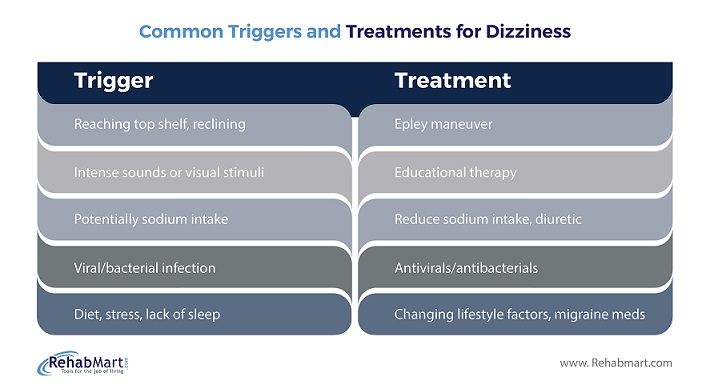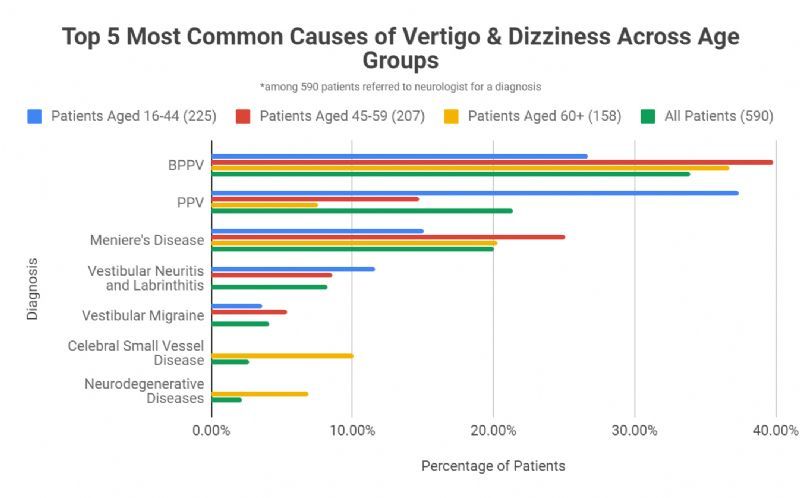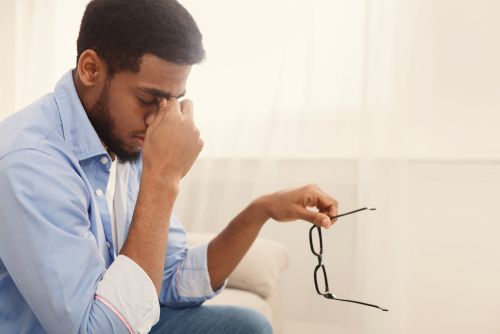 Written by Hulet Smith, OT
Written by Hulet Smith, OT

If you’ve been feeling dizzy lately, you’re not alone.
In fact, between 30-40% of the US population will experience some degree of dizziness in their lifetime, with almost 1 in 5 adults seeking treatment for dizziness every year.
You might be asking yourself:
For starters, it helps to know that dizziness is categorized as a type of balance disorder.
In order to keep your balance, your brain receives information from three main parts of your body: your eyes, the vestibular system in your inner ears, and your muscular system.
Your brain then uses this information to process where you are in relation to the things around you, and makes adjustments as needed.
Any major disruption to one of these three areas can lead to symptoms like
That being said, being dizzy can be different for everyone, and the word itself can represent a variety of different experiences.
When someone claims to be dizzy, they might be feeling off-balanced, lightheaded, or faint; having spinning, floating, or tilting sensations, or even having blurred vision.
‘Dizziness’ is usually a combination of two or more of these feelings, as there is very rarely just one single symptom contributing to the problem.
Why Am I So Dizzy? Take RehabMart's Dizziness Self Quiz
It’s no secret that those who feel dizzy want to get rid of their symptoms as quickly as they can. But, in order to get relief as soon as possible, it’s important to understand what might be causing the dizziness.
By knowing the cause, you can take the next step to not only get rid of the symptoms, but to also keep them from coming back in the future.
Learning more about the main causes of dizziness can make things easier for you and your healthcare provider by saving time and money for all parties involved.
Sometimes feeling dizzy can be a result of things such as motion sickness, side effects from new medicines, head injuries, bacterial/viral infections, or even something as common as dehydration.
However, finding the source of your dizziness isn’t always that simple.
In fact, balance disorders such as dizziness are commonly caused by some sort of problem with the vestibular system, also known as the inner ear.
Problems with this complex system can often seem complex or intimidating, but it is important to understand them to get a better idea of what might be causing your dizziness.
The chart below breaks down the five most common causes of dizziness for three different age groups: 16-44, 45-59, and 60+.
Below the chart you will find an explanation of each of these conditions to see which of them most closely resembles the type of symptoms that you may be experiencing.

Benign Paroxysmal Positional Vertigo, or BPPV, is the number one most common cause of dizziness.
But, there’s a lot of clinical terminologies there, so let’s break it down, starting with probably the most common of the four words there, ‘vertigo.’
The word ‘vertigo’ is a pretty common expression, but most people aren’t that familiar with its actual meaning.
'Vertigo’ by itself is not the name of a condition, but rather the name of a particular sensation. Specifically, vertigo refers to a feeling of internal or external spinning associated with a sensation of dizziness.
So, if you break down the name of BPPV, you can better understand what it means.
When you put it all back together, you can summarize BPPV by saying it is a non-harmful condition that causes a sudden spinning sensation triggered by the movement of the body, more specifically the head.
Now you’re probably wondering: what makes people get BPPV?
Well, it’s all caused by small crystals in the inner ear called otoconia.
These crystals are all in certain positions in the inner ear to give the brain feedback on the exact position of the head.
Sometimes, these crystals can get loosened from their original position and lodged somewhere else, leading them to give incorrect feedback to the brain.
So certain movements will trigger episodes, but you won’t feel dizzy all the time.
PPV, commonly known as perceived postural-perceptual dizziness (PPPD), is a newly discovered condition that’s difficult to diagnose due to the mystery surrounding exactly what causes it and why it happens.
PPPD is diagnosed when someone has persistent dizziness and unsteadiness but no vertigo occurring for more than half of the days in a three-month period. And unfortunately, there’s no test to know if you have it.
Like MS or fibromyalgia, PPPD is a functional disorder, meaning that it’s a condition that is almost impossible to find through examination, and is diagnosed when no other cause can be found for your symptoms.
PPPD, specifically, is often found in people who have previously had some other type of dizziness or vestibular disorder that has been treated and gone away.
It usually occurs after viewing intensely colored or moving visual stimuli like bright patterns or large crowds, or along with quick movements of the head.
This chronic form of dizziness is very common, and is increasingly harder to cure based on how long the symptoms have gone on for.
So, if you think you may have this, it is important to seek out treatment options right away.
Delayed endolymphatic hydrops (DEH) is a term that refers to the over-accumulation of fluid in the inner ear, and it’s what leads to the development of Meniere’s disease.
Fluid can build up in the inner ear due to a variety of causes, including poor drainage, allergic reactions, viral infections, migraine headaches, blows to the head, or just an inherited tendency, though scientists still aren’t 100% certain exactly why Meniere’s disease occurs.
In both DEH and Meniere’s disease, fluid builds up inside the labyrinth portion of the inner ear.
This extra fluid impedes signals between the ear and the brain, causing both vertigo because of blocking vestibular signals, and hearing problems because of blocking hearing signals.
And, even though DEH is an early sign of Meniere’s disease, someone with DEH doesn’t always meet all the requirements to be diagnosed with Meniere’s disease.
Both conditions are categorized together because they typically have the same symptoms and treatment.
Those with either condition will typically experience random episodes of vertigo, partial hearing loss, tinnitus or ringing in one or both ears, and a feeling of fullness in the ear.
As you can see in the chart above, Meniere’s disease and DEH are increasingly more common with age and more frequently affect women than men.
You may have Meniere’s disease if you have no other probable cause of your dizziness, multiple dizzy episodes lasting twenty minutes to twenty-four hours, and documented hearing loss in the affected ear during or after an episode.
Vestibular Neuritis and Labyrinthitis are both conditions that result from an infection damaging the vestibular nerve.
The vestibular nerve controls information about gravity and movements of the head, so both conditions involve feelings of dizziness and vertigo.
The main difference between the two is that while vestibular neuritis usually occurs as a result of viral infection, labyrinthitis involves both a viral and bacterial infection.
Bacterial infection will occur in the middle ear and involve the cochlear nerve as well as the vestibular nerve, meaning that labyrinthitis often involves hearing loss or ringing in the ears.
Both of these conditions can cause nausea, vomiting, and increased sensitivity to head movement.
Fortunately, these symptoms usually clear up either on their own or with the help of medication to remove the infection.
Vestibular migraines are similar to normal migraines, but with a few key differences including the fact that they may not involve pain like a traditional migraine headache.
While they do often present as a headache, vestibular migraines have a much more intense effect on balance, causing dizziness or vertigo.
Additionally, like most migraines, they often cause sensitivity to bright lights and loud noises as well as stiffness or pain in the neck or ears.
Causes of vestibular migraine are not completely understood, but they are thought to be related to electrical charges in the brain that set off pain receptors.
If you think you may have this condition, be sure to track your migraines to try and see patterns in what might be triggering your episodes.
This information could be very useful in helping you manage or decrease the frequency of episodes or to speed up the diagnostic process with a specialist.

The five causes of dizziness we listed here are the most common reasons why people might feel dizzy.
However, when you look at age groups, the most common diagnoses for people over the age of 60 change a little bit.
Instead of vestibular migraine and vestibular neuritis/labyrinthitis, older populations can cite cerebral small vessel disease and neurodegenerative diseases as the fourth and fifth most common diagnoses respectively.
Understanding the causes, diagnosis, and treatment of balance disorders and dizziness in the elderly is a much more complicated topic due to the unique combination of factors that co-occur with aging.
If you want to learn more about dizziness and balance disorders in the elderly, we’ve also written a full article on the topic.
Why Am I So Dizzy? Take RehabMart's Dizziness Self Quiz

Outside of these five most common causes of dizziness, there are a few other well-known conditions that may be the source of your symptoms.
Riding in a boat, car, or train may sometimes lead to nausea and dizziness due to the conflicting signals from your eyes and body.
To relieve symptoms, focus on something far away, keep your head still, avoid strong smells, and eat light foods.
Also a form of motion sickness, this condition causes a feeling of continuous bobbing, swaying, or rocking which occurs after long periods of traveling on the sea, such as during a cruise.
Running on a treadmill for extended periods of time can also cause this.
Symptoms usually stop within a few hours of after discontinuing the activity, but can sometimes last longer.
Chances are, even if your current instance of dizziness is something else, you’ve experienced orthostatic hypotension.
Although it sounds complicated, it basically refers to the drop in blood pressure that often happens when you stand or sit up quickly, causing a brief period of lightheadedness.
The lightheadedness occurs within 15 seconds of standing up, and lasts no longer than 20 - 30 seconds.
This condition involves the leakage of fluid from the inner ear into the middle ear, often caused by some sort of trauma.
When this happens, it can cause unsteadiness, dizziness, and nausea that can worsen with activity.
A PLF can occur after a head injury, scuba diving (from dramatic changes in air pressure), physical exertion, ear surgery, or chronic ear infections.

Dizziness and balance disorders are incredibly common but often misunderstood by doctors and patients alike.
This leads to large amounts of time and money being wasted from both parties through complicated, unnecessary, and uncomfortable tests.
For that reason, it is vital to have a solid understanding of what might be causing your symptoms.
The best way to do this is to keep track of the intensity and duration of your symptoms, as well as anything that might be triggering them.
For less serious conditions, you could use this information to get back on your feet and symptom-free without having to dedicate a bit of your time and money to take a trip to the doctor.
For the more serious or complicated conditions, having this information will enable your healthcare provider to more quickly and easily navigate through the diagnostic process, skipping unnecessary tests.
When it comes to being in charge of your health, knowledge is power.
Everyone wants immediate relief of their symptoms, and oftentimes the solution is only one Internet search away.
Do your part in understanding what might be going on, and your doctor, body, and bank account will thank you.
Why Am I So Dizzy? Take RehabMart's Dizziness Self Quiz

Co-founder/CEO of Rehabmart, Pediatric Occupational Therapist, husband, and father. Passionate about connecting special needs kids with superb nutrition, sensory integration, and complementary health strategies. Excited about Rehabmart's mission to become the premier online educational platform which empowers caregivers by spotlighting innovative devices and interventions to achieve optimal patient response and recovery.